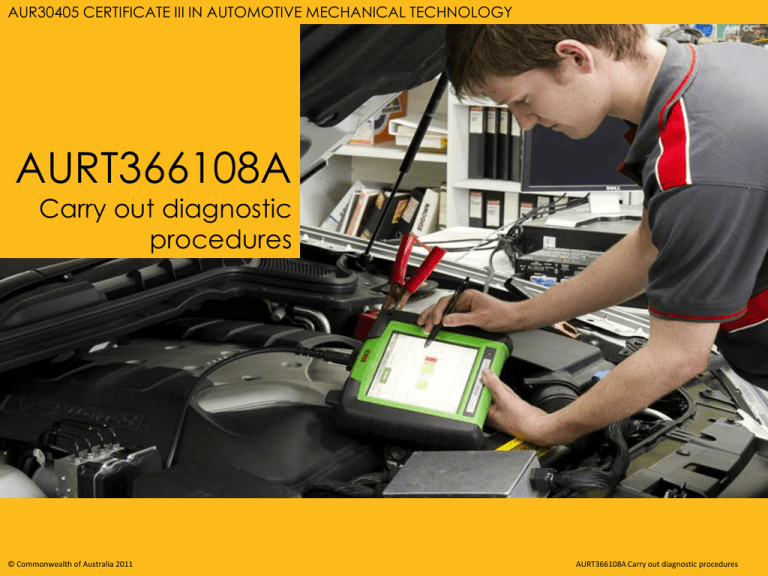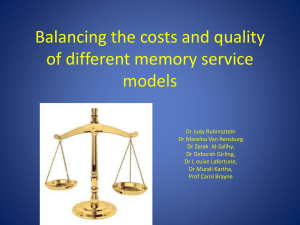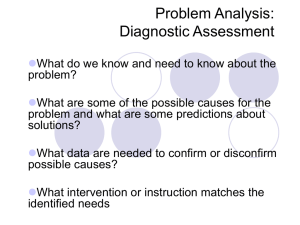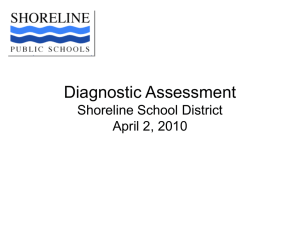
AURT366108A
AUR30405
CERTIFICATE
CARRY OUT
III INDIAGNOSTIC
AUTOMOTIVE
PROCEDURES
MECHANICAL TECHNOLOGY
AURT366108A
Carry out diagnostic
procedures
© Commonwealth of Australia 2011
AURT366108A Carry out diagnostic procedures
AURT366108A CARRY OUT DIAGNOSTIC PROCEDURES
2
What is ‘diagnosis’?
When motor vehicles and other engine-driven machinery break down,
automotive technicians must be able to:
1. Identify the problem.
2. Find the cause of the fault.
3. Fix it.
© Commonwealth of Australia 2011
This is called
DIAGNOSIS,
fault finding or trouble
shooting.
This is called REPAIR.
AURT366108A Carry out diagnostic procedures
AURT366108A CARRY OUT DIAGNOSTIC PROCEDURES
3
Normal and abnormal states
Normal state
Abnormal state
Things are working the
way they should
Things are NOT working the
way they should
X
?
Repair
© Commonwealth of Australia 2011
Diagnosis
AURT366108A Carry out diagnostic procedures
AURT366108A CARRY OUT DIAGNOSTIC PROCEDURES
4
Think safety
Result of unsafe
work practices
Costs
Pain, possible disablement
Medical costs
Injury to a worker
Loss of income
Government safety inspections
Increased workplace insurance
premiums
Cost to the workshop
Damage to a vehicle
Reduced profits
Damaged reputation
© Commonwealth of Australia 2011
AURT366108A Carry out diagnostic procedures
AURT366108A CARRY OUT DIAGNOSTIC PROCEDURES
5
Think safety
Follow all Occupational Health and Safety
guidelines
Obey all safety instructions from your employer.
Wear PPE (personal protective equipment):
• eye protection
• gloves
• well-fitting overalls
• safety footwear.
© Commonwealth of Australia 2011
AURT366108A Carry out diagnostic procedures
AURT366108A CARRY OUT DIAGNOSTIC PROCEDURES
6
Workshop Hazards
Hazard
What can happen?
Lifting
Hurt your back or shoulders.
Exhaust gases
Carbon monoxide (CO) in the exhaust can kill
you.
Loose clothing
Can get caught in moving parts.
© Commonwealth of Australia 2011
AURT366108A Carry out diagnostic procedures
AURT366108A CARRY OUT DIAGNOSTIC PROCEDURES
7
Workshop Hazards
Hazard
What can happen?
Electric
shock
Ignition systems produce voltages of 30,000 to
50,000 volts.
Can kill you.
Batteries
Battery acid will destroy clothing, burn skin, and
can cause blindness if it gets in your eyes.
© Commonwealth of Australia 2011
AURT366108A Carry out diagnostic procedures
AURT366108A CARRY OUT DIAGNOSTIC PROCEDURES
8
Advantages of good diagnosis
Who?
The customer
Benefits
Time and money not wasted
Vehicle is off the road for minimum amount of time
No re-work required through wrong diagnosis
The technician
Skilled and efficient employees valued and rewarded by
employer
Satisfaction of doing a good job
The workshop
Job completed in shortest possible time so more jobs
can be completed in a day
Warranty costs down because work is high-quality
© Commonwealth of Australia 2011
AURT366108A Carry out diagnostic procedures
AURT366108A CARRY OUT DIAGNOSTIC PROCEDURES
9
What is a symptom?
The engine cuts
out at the traffic
lights!
The clutch
feels funny ...
Something that is abnormal
Something the driver can
see, hear, feel or smell
It’s making a
whoo-whoowhoo noise.
© Commonwealth of Australia 2011
The front tyres
have worn out
very quickly.
AURT366108A Carry out diagnostic procedures
AURT366108A CARRY OUT DIAGNOSTIC PROCEDURES
10
What is a fault?
A fault = abnormal condition in a vehicle system or component.
May be:
• a hardware fault (things which are broken, worn etc)
• a software fault (in an electronic module).
Customer notices a
symptom
Symptom is caused by
a fault
The clutch
feels funny ...
The clutch
master cylinder
might be leaking
…
© Commonwealth of Australia 2011
AURT366108A Carry out diagnostic procedures
AURT366108A CARRY OUT DIAGNOSTIC PROCEDURES
11
What caused the fault?
Customer notices a
symptom
The clutch
feels funny ...
© Commonwealth of Australia 2011
Symptom is caused by
a fault
What is the cause of
the fault?
The clutch
master cylinder
might be leaking
…
Contaminated
clutch fluid has
damaged the
master cylinder
seals.
AURT366108A Carry out diagnostic procedures
AURT366108A CARRY OUT DIAGNOSTIC PROCEDURES
12
Types of diagnostic procedures
All diagnostic procedures are logical and systematic.
1. Step-by-step
Three common approaches are:
Step 1
Step 2
3. Black Box
Step 3
Step 4
Feedba
ck loop
Output
Input
BLACK
BOX
2. Branching
Step 5
Step 6
© Commonwealth of Australia 2011
AURT366108A Carry out diagnostic procedures
AURT366108A CARRY OUT DIAGNOSTIC PROCEDURES
13
Feedback loop
1. Confirm the fault exists
2. Gather information
3. Consider the information
Carry out
more tests
4. Fault and cause identified?
YES
NO
5. Repair the fault
6. Check all systems to make sure
fault is fixed
© Commonwealth of Australia 2011
AURT366108A Carry out diagnostic procedures
AURT366108A CARRY OUT DIAGNOSTIC PROCEDURES
14
The six steps
Step 1: Confirm the symptoms
• Is there actually a fault?
• Are you and the customer talking about the same thing?
Step 2: Gather information
• Question the customer.
• Do a “look and feel” test.
• Consult service bulletins, workshop manuals, on-board trouble codes
or other information sources.
Step 3: Consider the information and evidence gathered
• Are there clues about where the problem is?
• What things are not possible, and what things are possible?
© Commonwealth of Australia 2011
AURT366108A Carry out diagnostic procedures
AURT366108A CARRY OUT DIAGNOSTIC PROCEDURES
15
The six steps
Step 4: Locate the fault and cause of the fault
• Do you need to carry out more tests?
Step 5: Repair the fault
• What is the most appropriate method of repair?
Step 6: Check all systems and confirm the fault is fixed
• Does the faulty system operate correctly?
• Do all related systems operate correctly?
• Have any new faults been introduced?
© Commonwealth of Australia 2011
AURT366108A Carry out diagnostic procedures
AURT366108A CARRY OUT DIAGNOSTIC PROCEDURES
16
Recording the work
Job No.
Date ………………
Time Received ………………..
Service
Adviser……………
…..
Technician
……………………..
Customer Name & Address
……………………………………………………………...
………………………………………………………………
………………………………………………………………
TEL…………………………………………………………
Year/ Make/ Model
Customer Concern
Kilometres …………….
………………………………………
Reg. No…………………………….
VIN No……………………………..
Engine No………………………….
Authority to Repair
Signature………………
Date…/…./…….
Date & Time Promised
Description of Work Carried Out
Sample Job Card
TBA
Time on
Time off
Parts
Cost
Additional Work- Authority to
Repair
………………………………………
Signature………….
……………………….Date…../
…./…
OR via Telephone
Time
received………………...
Email
Fax
© Commonwealth of Australia 2011
AURT366108A Carry out diagnostic procedures
AURT366108A CARRY OUT DIAGNOSTIC PROCEDURES
17
Parts of a report
A. Introduction
•
What is the report about?
•
Why is it being written?
B. Procedure
•
What was done? What tests? What equipment?
•
Any special conditions?
C.
Results of tests & investigations
•
What are the results of any tests you did?
•
What is the condition of component/s?
© Commonwealth of Australia 2011
AURT366108A Carry out diagnostic procedures
AURT366108A CARRY OUT DIAGNOSTIC PROCEDURES
18
Parts of a report
D. Conclusion
•
What is the fault?
•
What is the cause?
•
How did you repair it?
E.
Recommendations
•
Do you think any further action is needed?
© Commonwealth of Australia 2011
AURT366108A Carry out diagnostic procedures
AURT366108A CARRY OUT DIAGNOSTIC PROCEDURES
19
Branching diagnostic procedures
• Sometimes called a ‘decision tree’ or a
‘trouble tree’.
• Ask and answer ‘yes or no’ questions.
Oil level correct?
NO
• Sometimes found in workshop manuals.
YES
Pressure correct at
250-280kPa?
YES
NO
Pressure
too low
Pressure too
high
Check for
restrictions
YES
NO
OK
Clean / replace
filter, recheck
pressure
NOT OK
© Commonwealth of Australia 2011
Part of a lubrication
‘decision tree’
AURT366108A Carry out diagnostic procedures
AURT366108A CARRY OUT DIAGNOSTIC PROCEDURES
20
Black Box Diagnosis
• Useful with electronicallycontrolled systems.
• Concentrates on testing
everything outside the box.
• Most likely a faulty sensor or
actuator will be found.
• If all inputs, outputs and
connections are OK, the
problem must lie within the
ECU.
© Commonwealth of Australia 2011
Input 1
Input 2
ECU
‘black
box’
Output 1
Output 2
Input 3
Output 3
Input 4
AURT366108A Carry out diagnostic procedures
AURT366108A CARRY OUT DIAGNOSTIC PROCEDURES
21
On-board diagnostics (OBD)
• Reports electronically when something is not operating correctly.
• Gathers information from sensors and compares it with stored
specifications.
• When a specified fault occurs, the driver is alerted by a light on the
dashboard.
Malfunction Indicator light
© Commonwealth of Australia 2011
AURT366108A Carry out diagnostic procedures
AURT366108A CARRY OUT DIAGNOSTIC PROCEDURES
22
Diagnostic trouble codes
Older OBD systems used lights to flash out a Diagnostic Trouble Code (DTC)
number. This code number told the technician what the fault was.
Example: a V6 Holden VN
might give 2 flashes, then a
pause followed by 3 flashes =
DTC 23.
2 flashes, pause,
3 flashes
DTC 23 = ‘MAT Sensor (voltage high)’.
Now the technician must find what that voltage actually is, and why it is high.
Older systems provide only a fairly small number of DTCs.
© Commonwealth of Australia 2011
AURT366108A Carry out diagnostic procedures
AURT366108A CARRY OUT DIAGNOSTIC PROCEDURES
Scan tools
23
• Now we use scan tools to read diagnostic trouble codes.
• The scan tool displays the DTC on a screen.
• Throttle position
• Air flow meter
‘Check Engine’ Light
• Engine RPM
• Coolant temperature
• Intake air
temperature
INPUTS
• Ignition control
ECU
OUTPUTS
• Oxygen sensor
• Fuel injectors
• Idle speed
• Crank angle
• EGR control
• Map sensor
• Knock sensor
• Road speed
Data Link
Connector
• Diagnostic
Trouble Codes
• Vehicle
information
• System data
© Commonwealth of Australia 2011
AURT366108A Carry out diagnostic procedures
AURT366108A CARRY OUT DIAGNOSTIC PROCEDURES
24
OBD 2
• OBD 2 is a universal system.
• In Australia since 2006, all new cars must have
OBD 2.
• Monitors emission-related systems and reports
faults.
• Aims to reduce emissions.
© Commonwealth of Australia 2011
AURT366108A Carry out diagnostic procedures
AURT366108A CARRY OUT DIAGNOSTIC PROCEDURES
25
OBD 2
All vehicles must have the same data link
connector for a scan tool.
OBD 2 Data Connector
Any OBD 2 scan tool should be able to
connect to it.
The data link connector must be easily
accessible near the driver’s seat.
OBD 2 connector located in lower dash area
© Commonwealth of Australia 2011
AURT366108A Carry out diagnostic procedures
AURT366108A CARRY OUT DIAGNOSTIC PROCEDURES
26
Features of OBD 2
1. ‘Check Engine’ light
• The system turns on the light to indicate a fault.
• The light may be turned off again if the fault is absent for the next 3
driving cycles.
2. ‘Freeze Frame’ information
When a fault is first detected, the system stores a ‘snapshot’ of some
information.
© Commonwealth of Australia 2011
AURT366108A Carry out diagnostic procedures
AURT366108A CARRY OUT DIAGNOSTIC PROCEDURES
27
Features of OBD 2
3. Readiness testing
• Monitors and tests all emission-related components and systems
during a drive cycle.
• Reports ‘ready’ or “not ready’ to a scan tool.
4. Diagnostic Trouble Codes
• DTCs are a combination of letters and 4 numbers.
• Have the same meaning for all vehicles.
• Manufacturers can add codes for other non-emissions systems if
they choose.
© Commonwealth of Australia 2011
AURT366108A Carry out diagnostic procedures
AURT366108A CARRY OUT DIAGNOSTIC PROCEDURES
28
What OBD 2 codes mean
Which vehicle system set the code?
P - power train
Fuel and air
metering system
B - body system
C - cChassis system
P 0 1
0 - is it a code required by the
government?
1 - or is it a manufacturer’s code?
15
Coolant Temperature
circuit
P0115 = Engine Coolant Temperature Circuit Malfunction
© Commonwealth of Australia 2011
AURT366108A Carry out diagnostic procedures
AURT366108A CARRY OUT DIAGNOSTIC PROCEDURES
29
© Commonwealth of Australia 2011
ISBN: 978-1-876838-30-0
This document is available under a “Free for Education” licence for educational purposes – see http://www.aesharenet.com.au/FfE2 for details.
This work is copyright. You may download, display, print and reproduce this material in whole or in part or in modified form (retaining this notice) for your
personal, non-commercial use or use within your organisation. If you use, display, or reproduce this material or a modified form of it in whole or in part within
your organisation you must include the following words in a prominent location within the material in font not less than size 12: ‘The views expressed in this
publication do not necessarily represent the view of the Minister for Education or the Australian Government. The Australian Government does not give any
warranty nor accept any liability in relation to the contents of this work’. Apart from any use as permitted under the Copyright Act 1968, all other rights are
reserved. Requests and inquiries concerning reproduction and rights should be addressed to the Commonwealth Copyright Administration, Attorney General’s
Department, Robert Garran Offices, National Circuit, Barton ACT 2600 or posted at http://www.ag.gov.au/cca.
Funded under the Workplace English Language and Literacy (WELL) Program by the Australian Government Department of Education, Employment and
Workplace Relations.
The views expressed in this publication do not necessarily represent the view of the Minister for Education or the Australian Government. The Australian
Government does not give any warranty nor accept any liability in relation to the contents of this work.
© Commonwealth of Australia 2011
AURT366108A Carry out diagnostic procedures







